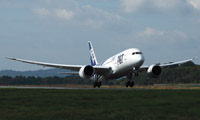News Backgrounder
Back in business - the B787 Dreamliner
It appears Boeing’s B787 Dreamliner grounding nightmare is finally over. Last month, U.S. and Japanese regulators approved changes to the plane’s battery system to eliminate potential overheating problems, giving the go-ahead for a return to service.
May 1st 2013
For All Nippon Airways (ANA), the Dreamliner’s launch customer, it was a speedy return to the skies for its fleet when, just two days after the Japan Civil Aviation Bureau (JCAB) followed the U.S. Federal Aviation Administration (FAA) lead and approved a return to service late last month, the airline operated a trouble-free two-hour test flight from Tokyo’s Haneda airport. Read More »
 |
| 'This is a comprehensive and permanent solution with multiple layers of protection' |
| Ray Conner President & CEO Boeing Commercial Airplanes |
On board to display their full confidence in the re-designed battery compartment were ANA chairman, Shinichiro Ito, and the president of Boeing’s commercial aircraft division, Ray Conner.
But ANA, which has 17 Dreamliners, and Japan Airlines (JAL), which has seven, won’t be rushing the planes into commercial service. Ito said ANA would start B787 services on June 1.
The carriers will operate a number of test flights for each of their aircraft. Dreamliner pilots – ANA has 180 and JAL 150 – will undergo refresher training flights this month.
In addition, once the planes are carrying paying customers, ANA and JAL will take extra measures such as monitoring battery voltage remotely and putting in place a maintenance schedule that will involve removal of some batteries from their aircraft every few months for checks.
The global Dreamliner fleet, ANA and JAL has, almost half the B787s in operation, was grounded on January 16 after problems emerged with overheating of the aircraft’s lithium-ion batteries.
During the days previously the batteries had caused a fire aboard a JAL B787 parked at Boston airport and an ANA flight was forced to make an emergency landing in Japan because of another battery overheating incident.
Approval of an improved battery system was granted by the FAA after the agency conducted an extensive review of certification tests.
The tests were designed to validate that individual components of the battery, as well as its integration with the charging system and a new enclosure, all performed as expected during normal operation and under failure conditions.
 |
| B787 Dreamliner: back in the air with ANA next month |
Testing was conducted under the supervision of the FAA over a month-long period beginning in March.
“The FAA set a high bar for our team and our solution,” said Boeing president and chief executive, Jim McNerney.
The improved battery system includes design changes to both prevent and isolate a fault should it occur. In addition, improved production, operating and testing processes have been implemented.
The new steel enclosure system is designed to keep any level of battery overheating from affecting the airplane or being noticed by passengers.
“This is a comprehensive and permanent solution with multiple layers of protection,” said Boeing Commercial Airplanes president and chief executive, Ray Conner.
“The ultimate layer of protection is the new enclosure, which will ensure that even if a battery fails, there is no impact to the aircraft and no possibility of fire. We have the right solution in hand, and we are ready to go.”
Boeing has deployed teams to locations around the world, including Japan, to begin installing improved battery systems on B787s.
Kits with the parts needed for the systems as well as new batteries, were ready for shipment as soon as approval came through.
Teams were assigned to individual customers, with modifications beginning on aircraft approximately in the order they were first delivered.
“We are all very grateful to our customers for their patience during the past several months. We know it hasn’t been easy on them to have their 787s out of service and their deliveries delayed,” said Conner.
Boeing also has begun installing the changes on new aircraft at its two B787 final-assembly plants.
Deliveries were expected to resume this month. The planemaker said that despite the disruption to deliveries that began in January, it now expects to complete all planned 2013 deliveries by the end of the year. It said the battery issue will have “no significant impact” to its 2013 financial forecast.
The road back has been a tough one for Boeing, its customers and regulators. The manufacturer spent more than 100,000 hours developing test plans, building test rigs, conducting tests and analyzing the results to ensure the proposed solutions met all requirements.
Boeing also engaged a team of more than a dozen battery experts from across multiple industries, government, academia and consumer safety to review and validate developments and findings.
Approval of the modifications has come as a huge relief to Japanese airlines. It is expected that by the end of this month, ANA and JAL will have cancelled 4,300 flights caused by the groundings of the B787s affecting more than 135,000 passengers.
Once the jets are back in the air, Boeing will face its next challenge: sitting down with Dreamliner customers to negotiate compensation.